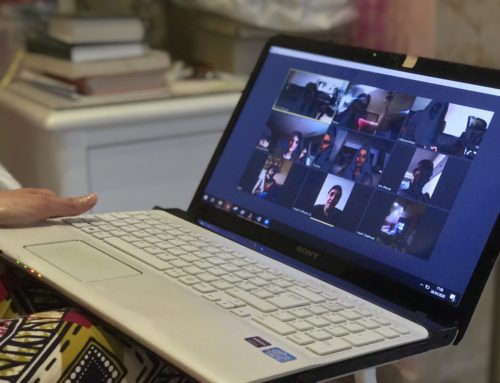We’re back with more of L. Danielle Baldwin’s expert advice related to online newsrooms.
 L. Danielle Baldwin is an award-winning digital strategist with more than 20 years of experience in design, content and media strategy, and web development. She has led social media and marketing efforts for notable startups and socially-conscious nonprofits as well as national and regional businesses. She loves bad karaoke, is a foodie and lives in Raleigh, North Carolina with her seven pound fur-baby, Andy, who has his own Twitter and Instagram pages.
L. Danielle Baldwin is an award-winning digital strategist with more than 20 years of experience in design, content and media strategy, and web development. She has led social media and marketing efforts for notable startups and socially-conscious nonprofits as well as national and regional businesses. She loves bad karaoke, is a foodie and lives in Raleigh, North Carolina with her seven pound fur-baby, Andy, who has his own Twitter and Instagram pages.
I interviewed Danielle last week and her tips for online newsrooms cover both Content and Technology.
In case you missed it, check out: Expert Advice about Online Newsrooms, Part 1: Great Content
Here are a few technical ways to improve your online newsrooms:
Provide Digital Assets – Digital assets helpful to have in your newsroom would include:
- Organizational logos, product images, project or initiative-specific images and graphics
- Images of key staff, personnel, media-friendly and interesting images of your organization at work, images from events, etc.
- High-quality, web-optimized video
It is important to make sure your digital assets are of high quality and optimized for the web and for social sharing. They should be small enough in size that they are not hard to download or link to and they should be of high enough quality that someone would want to share the information.
Search Engine Optimization – If your organization produces a lot of content, has a long history, has multiple chapters, locations or initiatives, provide users with a way to thoroughly search through your content to easily find what they are looking for on your site. There are several ways you can increase a site user’s ability to find content within your newsroom and on your site in general:
- Make your content searchable using assigned categories or tags
- Optimize new and old press and news releases for online search, assign categories and tags to these as well so they can be included in search results just like web content
- Make all PDFs in your newsroom searchable by creating them within a text editing software like Microsoft Word or by scanning them with an OCR software application that will convert old PDFs into searchable documents
Know a Little HTML – Find someone in your organization who knows and understands HTML enough to be able to assist you with increasing a user’s ability to add in webpage and website metadata to your newsroom page, subpages and content sections. Accurate and thorough metadata is vital in the efforts to increase visibility and searchability within the major search engines. It also allows your organization to remain in control of the descriptions and search words, keywords and tags used to identify, organize and rank your content and your website.
Don’t Forget To Share Obvious Content – Your newsroom or media center is also a great place to provide established organizational information such as White papers and annual reports. You already know that people are coming to your site to find this information, so why not make sure you provide them with as many ways as possible to find this information.
Include Social Shares – Offer newsroom visitors a way to share information found in your newsroom and/or media center to social media. Where possible and where it makes sense, offer embed codes for images, slideshows and videos. Add icons to various social media platforms that allow users to share your content with just one click from the newsroom.
Make Your Site “Responsive” – One of the best and most efficient ways to make sure your newsroom and its content rank well and provide users with the best overall method of easy access to content and assets is to make your website responsive. Responsive sites are also mobile friendly and easily accessible via multiple devices and types of screens. The more you can optimize your site in a responsive manner, the better and more consistent your content will look to site users no matter what device or screen they may view it upon now and into the future.
Analyze the Analytics – Connect your newsroom/media center to Google Analytics to find out what visitors search for the most and make sure you add that type of information to your newsroom. You can also use analytics to find out where visitors enter and exit your site when they visit, how long they spend on any particular page or post and what they click on the most when they visit.
To uncover more about the specific behavior of your newsroom visitors, use the website CrazyEgg to find out what areas of your newsroom or media center visitors click on the most or the “hot spots” on the page. This information will help you determine the best arrangement or order of the information provided on your newsroom page – based on how “hot” or popular that specific area of your newsroom seems to be for visitors.
Pay special attention to your site’s “bounce rate” in Google Analytics. A high bounce rate for your website usually means that site visitors (and newsroom visitors in particular) are not finding the information they are actually looking for when they come to your site and as such they leave rather quickly.
Encourage SEO Teamwork– Get everyone on the same page. Put together a spreadsheet of keywords, hashtags, important links and meta-tags and share that list with the entire organization. Anyone who writes any form of content will find this list useful. Providing a list of commonly used and approved terms not only provides a true baseline for all writers when it comes to writing content that includes popularly search words, SEO approved phrases and terms as well as hot hashtags to use when sharing content on social media.
The more these commonly used words are incorporated into regular content across your website, the better your ranking will become. A simple way to think of SEO is to compare it to crowds. The more people use the same words in similar content on the same site and social media, the more these words are associated with your organization’s specific content both on and off your site. Search engines gather this information and will begin to associate these commonly used terms with your content as well. The more clear pathways you provide to search engines to find your content and the more you use the same words and phrases to point back to content on your site, the better your search ranking will become.
Adjust Permalinks – (FROM Yoast.com) The permalink is the full URL you see – and use – for any given post, page or other pieces of content on your site. It’s a permanent link, hence the name permalink. A permalink could include your domain name (www.yoast.com) plus what’s called a slug, the piece of the URL that comes after the domain name. This might include a date or a category or anything you please. A simple permalink makes a URL easy to understand and share.
Make sure the actual URL that takes users to your content are clean and easy to read as well. They should not be full of special characters, long complicated story titles or non SEO friendly terms. Google and other search engines search through URLS for content and terms related to the actual content on the page so make sure the URL for your page, post or news story is simple but informative. Use the following suggestions to create “pretty permalinks” that increase searchability and ranking:
- The entire title of your post or news story does not have to be in the title
- Include just enough to make the link readable but keep it to 4-6 words if at all possible
For instance, if the title of your article is “John Doe Wins the 2018 Award for Most Invisible Person;” the URL for this award should look something like this: https://www.website.com/John-Doe-Wins-Most-Invisible-Award-2018.
And last but not least…
Add a Main Keyword- for your news post or page in the URL for increased SEO.
Use categories and tags in a consistent way for all URLs, creating a naming convention for all posts and pages that will be used moving forward for the whole organization words like “and,” “in” and “the” can normally be omitted from URLs altogether. Do not use commas or other special characters.It is best practice to use hyphens to separate words within your URL.






